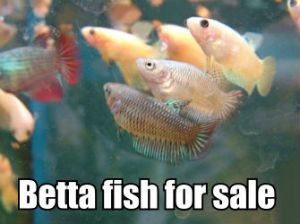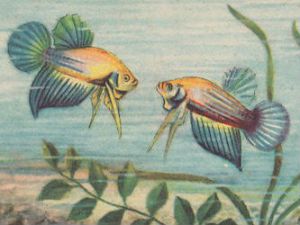
Betta Fish for Sale Online for Aquarists
Offering Betta splendens and dozens of Betta species for sale daily.

Best Place to Buy Betta - Betta splendens
Buy Betta Fish - Siamese fighting fish - from $4.99 to $89.00. Choose from hundreds of stunning Betta fish for Sale. Some include FREE shipping and overnight delivery to your door. Shop online and actually find what you're looking for the first time, there isn't a better way to shop. Welcome to BettaFishForSale.org a website created for beginning hobbyists with the purpose of organizing all the species of Bettas and making them available for purchase. Each day new fish are listed from fry to breeders so please visit often. See why Siamese fighting fish are a popular freshwater aquarium fish available in dozens of colors and finnage and scale types at affordable prices.Welcome to BettaFishForSale.org a website created for beginning hobbyists with the purpose of organizing all the species of Bettas and making them available for purchase. Each day new fish are listed from fry to breeders so please visit often. See why Siamese fighting fish are a popular freshwater aquarium fish available in dozens of colors and finnage and scale types at affordable prices.
Betta Article
This article presents the complete genus Betta and the entire species of fish belonging to this genus affectionately known as the Siamese fighting fish. These freshwater fish hale from Asia found in Cambodia, Malaysia, Thailand and Vietnam where they are called pla-kad translated it means biting fish. Betta splendens or B. splendens is notably the most popular in the aquarium trade and typically offered for sale in those little glass bowls.
The genus Betta is relatively large with some 70 named Betta species and 5 un-described Betta species. This group of colorful and small freshwater ray-finned fishes is classified in the gourami family known as (Osphronemidae). The genus Betta is said to be derived from ikan bettah, from a local Malay dialect.
Betta Characteristics
So what is so unique about Bettas anyway? These are just cute little colored fish that live in a small glass bowl, right? All Betta species are not equal in size and they vary in length from one inch namely B. chanoides to some 5 inches in length namely B. akarensis commonly called Akar betta.
What make Betta so amazing are not their gorgeous colors, finnage and dancing behavior or even bubble nests, it's their unique physical characteristic, an organ called the labyrinth. Betta's are anabantoids, and that means they have the ability to breathe atmospheric air by using their labyrinth organ. It is this feature that allows them to sustain living in low-oxygen water conditions in area like rice paddies, drainage ditches, puddles and slow-moving streams which eradicate most other fish.
Back to all Betta's are not equal, there are two groups of Betta based of their breeding behavior and husbandry in the aquarium. It has been noted that the two types are bubble nest breeders like B. splendens and mouthbrooder type like B. picta. There is speculation that the later; mouthbrooder type, known by the nickname "pseudo bettas" may have evolved from their nest-builder relatives as an adaptation to fast-moving streams in their habitats.
Betta Description
In particular B. splendens is by far the most popular among fish keepers and the most prevalent species of Betta available. Typically they reach some three inches in length and have the ability to live up to four years, that said some of claimed the may live up to a decade in rare cases. But Betta husbandry only begins with the Siamese fight fish B. splendens, there are 75 others species in the genus between named and described species to explore, collect and breed.
Despite the broad amount of species of Betta to select from B. splendens has is the most popular in terms of colors and finnage for variety of just this one species and this is attributed to extensive selective breeding by hobbyists and folks in the wholesale tropical fish business. Let's face it great colors, beautiful fins sell really well. This is no surprise to the hobby, we have seen this happen to Angel Fish and another cichlid; Flowerhorns, which is a hybrid but nevertheless offered in many colors and shapes from intense selective breeding. Interesting B. splendens in the wild has be documented as being dull in color found green and brown with relatively short fins in contrast to the stunning Veiltails, Deltas, Superdeltas and Halfmoon varieties of B. splendens.
Betta History
 Siamese fighting fish have a deep history in Thailand where they have been bred for over a 1,000 years from an ornamental perspective and for fighting purposes. Documentation from the 19th century further indicates other countries in the South-East Asian region include Cambodia and Vietnam as well in terms of keeping these fish where they thrive in stagnant ponds, rice paddies and road-side drains.
Siamese fighting fish have a deep history in Thailand where they have been bred for over a 1,000 years from an ornamental perspective and for fighting purposes. Documentation from the 19th century further indicates other countries in the South-East Asian region include Cambodia and Vietnam as well in terms of keeping these fish where they thrive in stagnant ponds, rice paddies and road-side drains.While in their natural habitat Bettas spar briefly until one of the two decides to back off and move on. Perhaps it was opportunity calling but it seems that fighting them provided to be an activity or event to watch and even gamble on. It is not unknown that large sums of money changed hands as a result of fighting this small fish with people wagering their homes.
As with any sickness gambling on the outcome of Betta fighting is just that, a sickness. This is no difference placing two male Bettas in tight quarters than of cock fighting and just as worse pit pull fighting, its plan cruel and unnecessary. It's so cruel and serious that even Peta.org, has taken a stance on protecting these fish and it is against the law in most states in the USA relative to gambling.
The story goes that the King? of Siam circa 1840 recognized the popularity and interesting in fighting these fish decided to license and collect them. The King was said to have given a medical scientist by the name of Dr. Theodor Cantor some of his prized fighting fish. Nearly a decade later Dr. Cantor published on this species by the name Macropodus pugnax at the time and in 1909 Charles Tate Regan the noted ichthyologist renamed the domesticated Siamese fight fish to Betta splendens. Charles Tate Regan is very well known for his work on cichlids including his work on the genus Cichlasoma.
Betta Diet
Betta fish are omnivorous in the wild where they are known to eat such items as insects, small fish, zooplankton, crustaceans and larvae from mosquitoes and other insects. From a hobby perspective Betta can be fed a host of items such as commercial Betta pellets, brine shrimp, bloodworms and krill. Additionally they will eagerly welcome live foods besides the aforementioned freeze-dried items. Offering live bloodworms, brine shrimp, daphnia and mosquito larvae are welcomed. Hatching brine shrimp at home seems to be the cost effective way to go.
Betta Colors
Overall Bettas are beautifully colored small freshwater fishes. That said B. splendens is affectionately known as "The Jewel of the Orient" because of their gorgeous colors and finnage and not to mention the numerous varieties available as a result of selective breeding efforts. This is in stark contrast to wild fish which may only show strong colors based on reactions to being agitated by other fish. Some of the colors offered in the hobby include red, blue, orange, yellow, pink, black, turquoise, cream, white and colors in the koi variations.
Betta Finnage and scale variations
One of the direct benefits of selective breeding is the fantastic creations of colors, different finnage and scale variations found in Siamese fighting fish.
List of the Top 15 Betta Tail Varieties
Comb Tail Betta (CT)
Crown Tail Betta
Delta Tail Betta
Double Tail Betta (DT)
Elephant Ear Betta
Fantail Tail Betta
Feather Tail Betta
Halfmoon Tail Betta (HM)
Over-Half-Moon Betta
Plakat Tail Betta (PK)
Rose Tail Betta (RT)
Round Tail Betta
Spade Tail Betta
Super Delta Tail Betta (SD)
Veil Tail Betta (VT)